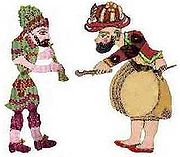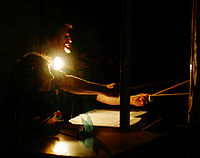
Karagöz and Hacivat
Encyclopedia

Turkish people
Turkish people, also known as the "Turks" , are an ethnic group primarily living in Turkey and in the former lands of the Ottoman Empire where Turkish minorities had been established in Bulgaria, Cyprus, Bosnia and Herzegovina, Georgia, Greece, Kosovo, Macedonia, and Romania...
shadow play
Shadow play
Shadow play or shadow puppetry Shadow puppets have a long history in China, India, Turkey and Java, and as a popular form of entertainment for both children and adults in many countries around the world. A shadow puppet is a cut-out figure held between a source of light and a translucent screen...
, popularized during the Ottoman
Ottoman Empire
The Ottoman EmpireIt was usually referred to as the "Ottoman Empire", the "Turkish Empire", the "Ottoman Caliphate" or more commonly "Turkey" by its contemporaries...
period. The central theme of the plays are the contrasting interaction between the two main characters. They are perfect foils of each other: Karagöz represents the illiterate but straightforward public, whereas Hacivat belongs to the educated class, speaking Ottoman Turkish
Ottoman Turkish language
The Ottoman Turkish language or Ottoman language is the variety of the Turkish language that was used for administrative and literary purposes in the Ottoman Empire. It borrows extensively from Arabic and Persian, and was written in a variant of the Perso-Arabic script...
and using a poetical and literary language. him (Farazi Kosmos). Although Karagöz has definitely been intended to be the more popular character with the Turkish peasantry, Hacivat is always the one with a level head. Though Karagöz always outdoes Hacivat’s superior education with his “native wit,” he is also very impulsive and his never-ending deluge of get-rich-quick scheme
Get-rich-quick scheme
A get-rich-quick scheme is a plan to acquire high rates of return for a small investment. The term "get rich quick" has been used to describe shady investments since at least the early 1900s....
s always results in failure. Hacivat continually attempts to “domesticate” Karagöz, but never makes progress. According to Turkish dramaturge Kırlı, Hacivat emphasizes the upper body with his refined manners and aloof disposition, while Karagöz is more representational of “the lower body with eating, cursing, defecation and the phallus."
Karagöz-Hacivat plays are especially associated with Ramadan
Ramadan
Ramadan is the ninth month of the Islamic calendar, which lasts 29 or 30 days. It is the Islamic month of fasting, in which participating Muslims refrain from eating, drinking, smoking and sex during daylight hours and is intended to teach Muslims about patience, spirituality, humility and...
. Until the rise of radio and film, it was one of the most popular forms of entertainment in Turkey. It survives today mainly in a toned-down form intended for audiences of children.
When the plays were first performed is unclear. Some believe that the first Karagöz-Hacivat play was performed for Sultan Selim I
Selim I
Selim I, Yavuz Sultân Selim Khan, Hâdim-ül Haramain-ish Sharifain , nicknamed Yavuz "the Stern" or "the Steadfast", but often rendered in English as "the Grim" , was the Sultan of the Ottoman Empire from 1512 to...
(reigned 1512–1520) in Egypt
Egypt
Egypt , officially the Arab Republic of Egypt, Arabic: , is a country mainly in North Africa, with the Sinai Peninsula forming a land bridge in Southwest Asia. Egypt is thus a transcontinental country, and a major power in Africa, the Mediterranean Basin, the Middle East and the Muslim world...
after his conquest of the country in 1517, but 17th century writer Evliya Çelebi
Evliya Çelebi
Evliya Çelebi was an Ottoman traveler who journeyed through the territory of the Ottoman Empire and neighboring lands over a period of forty years.- Life :...
stated that it had been performed in the Ottoman palace as early as the reign of Bayezid I
Bayezid I
Bayezid I was the Sultan of the Ottoman Empire, from 1389 to 1402. He was the son of Murad I and Valide Sultan Gülçiçek Hatun.-Biography:Bayezid was born in Edirne and spent his youth in Bursa, where he received a high-level education...
(reigned 1389–1402). In the 16th century, Ottoman Grand Mufti
Grand Mufti
The title of Grand Mufti refers to the highest official of religious law in a Sunni or Ibadi Muslim country. The Grand Mufti issues legal opinions and edicts, fatwā, on interpretations of Islamic law for private clients or to assist judges in deciding cases...
Mehmet Ebussuud el-İmadi
Mehmet Ebussuud el-Imadi
Ebussuud Efendi , also called "El-İmâdî", because the origin of their family was in İmâdiyye and Kurdish, "Abū s-Su'ūd" or "Hoca Çelebi", was a Hanafi Ottoman jurist and Qur'an exegete.He was the son of İskilipli Sheikh Muhiddin Mehmed Efendi...
issued a celebrated opinion allowing the performance of Karagöz plays.
According to one Turkish legend, the first performance of karagöz occurred when a lowly commoner visited the sultan. Rather than simply making a complaint, as most commoners did, he put on a short puppet show to tell a tale about the sultan’s corrupt officials. The myth states that the sultan was delighted by the performance so much that he appointed the puppeteer as his Grand Vizier and punished the corrupt officials that had inspired the puppeteer’s tale.Another story is that the two main characters, Karagöz and Hacivat (alternatively spelled as Hacivad) were actual people. These two legendarily clownish individuals were construction workers on a mosque in Bursa sometime in the mid-1300s. Their silly antics distracted the other workers, slowing down the construction, and the ruler at the time ordered their execution. They were so sorely missed that they were immortalized as the silly puppets that entertained the Ottoman Empire for centuries..
Whether these stories have any truth or not, the roots of karagöz stretch back to the unlikeliest of places; the island of Java. Javanese wayang, literally meaning “shadow,” is a form of shadow puppetry that dates back to 930 CE. These ornate shadow puppets, easy to transport due to their flat shape, were brought to the Middle East by Arab merchants and were adopted by the Egyptians, who practiced the art sporadically and without much convention for a few centuries. In the year 1517, Egypt was conquered and absorbed into the Ottoman Empire. The last Mameluke ruler, Selim Tumanbay, was overthrown by Sultan Selim I and executed. Selim I later chanced upon an Egyptian shadow puppet performance that recounted the entire execution (even including the fact that the rope broke twice.) Selim I, impressed by the performance, repaid the talented puppeteer by awarding him with 80 gold pieces and ordering him to travel with the royal caravan to Istanbul, where he would repeat the performance for his son. This gesture meant that Egyptian shadow theatre was officially adopted as Turkish entertainment—shadow puppet players then entertained the Ottoman royal court for years afterward.
Karagöz can be deceitful, lewd, and even violent. Other characters in these plays are the drunkard Tuzsuz Deli Bekir with his wine bottle, the long-necked Uzun Efe, the opium addict Kanbur Tiryaki with his pipe, Altı Kariş Beberuhi (an eccentric dwarf), the half-wit Denyo, the spendthrift Civan, and Nigâr, a flirtatious woman. There may also be dancers and djinns, and various portrayals of non-Turks: an Arab who knows no Turkish (typically a beggar or sweet-seller), a black servant woman, a Circassian servant girl, an Albanian security guard, a Greek (usually a doctor), an Armenian (usually a footman or money-changer), a Jew (usually a goldsmith or scrap-dealer), a Laz
Laz people
The Laz are an ethnic group native to the Black Sea coastal regions of Turkey and Georgia...
(usually a boatman), or a Persian (who recites poetry with an Azeri accent).
Karagöz plays

- Mukaddime: Introduction. Hacivat sings a semai (different at each performance), recites a prayer, and indicates that he is looking for his friend Karagöz, whom he beckons to the scene with a speech that always ends "Yar bana bir eğlence" ("Oh, for some amusement"). Karagöz enters from the opposite side.
- Muhavere: dialogue between Karagöz and Hacivat
- Fasil: main plot
- Bitiş: Conclusion, always a short argument between Karagöz and Hacivat, always ending with Hacivat yelling at Karagöz that he has "ruined" whatever matter was at hand and has "brought the curtain down," and Karagöz replying "May my transgressions be forgiven."
Sources:
Animators

Tambourine
The tambourine or marine is a musical instrument of the percussion family consisting of a frame, often of wood or plastic, with pairs of small metal jingles, called "zils". Classically the term tambourine denotes an instrument with a drumhead, though some variants may not have a head at all....
.
The puppets themselves have jointed limbs and are made from the hide of a camel or a water buffalo. The hide is worked until it is semi-transparent; then it is colored, resulting in colorful projections. The lamp for projection is known as a şem’a (literally "candle"), but is typically an oil lamp
Oil lamp
An oil lamp is an object used to produce light continuously for a period of time using an oil-based fuel source. The use of oil lamps began thousands of years ago and is continued to this day....
. Images are projected onto a white muslin
Muslin
Muslin |sewing patterns]], such as for clothing, curtains, or upholstery. Because air moves easily through muslin, muslin clothing is suitable for hot, dry climates.- Etymology and history :...
screen known as the ayna ("mirror"). Projections is from the rear, so the audience does not see the puppeteer. Puppets are typically 35–40 centimeters in height.

